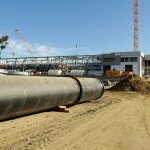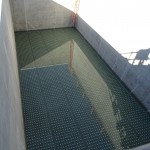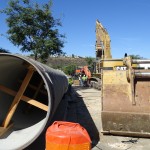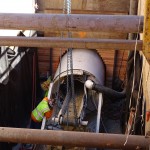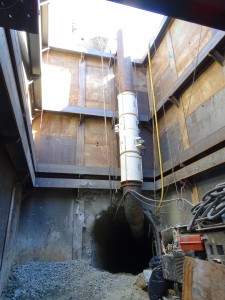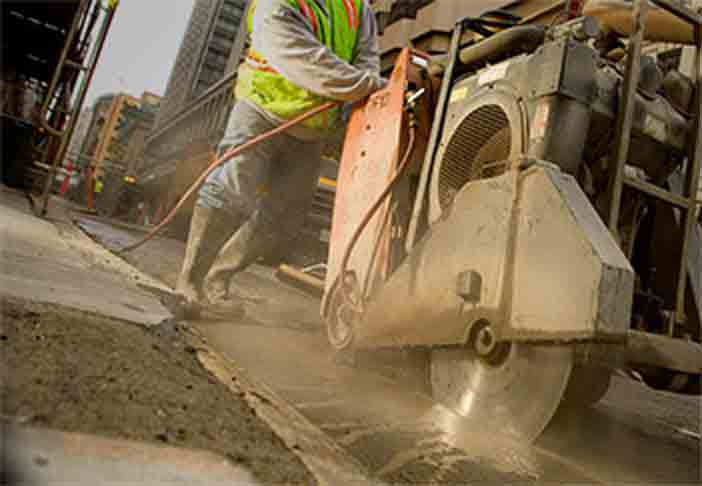Building Water Reliability
KSD Constructs the Carlsbad Desalination Project
Construction on the Carlsbad Desalination Project is more than two-thirds complete and is scheduled to be finished in late 2015. As near as that seems, it has taken many years to get to this point.
The project was first proposed in 1998 and challenged by more than a dozen lawsuits. More than 40 public meetings and hearings before the City of Carlsbad, California Coastal Commission, State Lands Commission and the San Diego Regional Water Quality Control Board were required before the project received its final approvals.
Only after all permits were received and lawsuits dismissed did the Board of Directors for the San Diego County Water Authority (SDCWA) approve a 30 year purchase agreement with the project’s owner – Poseidon Resources. Once the purchase agreement was in place construction began in December 2012.
The team of Kiewit Infrastructure, J.F. Shea Construction and IDE Technologies are building the $573 million desalination project. Kiewit and J.F. Shea joint-ventured to form Kiewit Shea Desalination (KSD). KSD is providing the engineering, procurement, and construction services for the project which includes a reverse osmosis treatment plant and a pipeline. IDE Technologies designed the reverse osmosis system and will operate and maintain the facility under a 30-year agreement.
The Plant
The Carlsbad Desalination Plant will be the largest in the Western Hemisphere, able to produce 50 million gallons of fresh water per day. More than 32,000 yards of concrete have been put in place for the facility which consists of an intake pump station, desalination plant, product water storage facility and pump station as well as a discharge pipeline.
The desalination plant is located on property leased from the Encina Power Station, a facility scheduled to be decommissioned in 2018. The desalination plant uses the discharged seawater that was used for cooling at the power station as its water source. An intake pump station, consisting of two intake pumps (plus one standby pump) pushes the seawater to pretreatment via a 72″ underground pipeline. More than 100 million gallons of seawater will be pumped up to the treatment facility every day.
The first stop within the treatment facility is pretreatment building. Here, 16 concrete holding tanks were constructed; each containing thousands of aeration nozzles. The addition treatment chemicals and the aeration process help to remove particulates and organic matter from the seawater.
After pretreatment, the water is run through a reverse osmosis process to remove the salt. In order to push the water through the reverse osmosis membranes, four 9,000 horsepower pumps were installed. More than 2,000 reverse osmosis tubes, each 24 feet in length separate more than 99% of the salt from the water.
At or ahead of schedule for the site work and concrete structures, construction of the reverse osmosis system proved to be difficult and caused the schedule to slide. The high-alloy stainless pipe used to connect the reverse osmosis tubes together has a great resistance to seawater corrosion. Unfortunately, the pipe’s corrosion resistant properties made welding it a challenge. While the rest of the plant was being built on a single shift, a second one was employed to make up the difference on the reverse osmosis system.
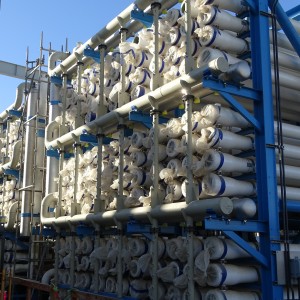
The reverse osmosis system consists of 14 ‘train’ systems – 24 foot reverse osmosis tubes arranged in 16 x 9 units.
To produce the 50 million gallons of fresh water every day, the desalination plant must process 100 million gallons of seawater. One of every two gallons of seawater processed through pretreatment and reverse osmosis becomes fresh water. The other gallon is used to carry the salts removed during the reverse osmosis process back to the ocean. A 60 inch high-density polyethylene (HDPE) ‘brine line’ pipe carries the salt-ladened water to the discharge line of the Encina Power Station as it returns to the ocean.
Before leaving the treatment facility, the final stop for the freshly desalinated water is the product water tank. The product water tank is an underground storage reservoir capable of holding 2.5 million gallons of water. The construction of the product water tank required many yards of dirt to be excavated and many yards of concrete to be placed. The project’s website contains some time–lapse videos of the excavation and the concrete pour.
In all, construction of the plant employed approximately 350 craftsmen, with about two-thirds being KSD employees. Through October, KSD has averaged 24 laborers; performing the concrete placement and form stripping, as well as underground work including backfill and excavation.
Some notable Laborer subcontractors on the plant include Underground Solutions (potholing), Hayward Baker, American Integrated Services (demolition), Baja Exploration, Underground Solutions, and Penhall Company.
Plant construction manager Brian Fetters said, “It has been great to work with the staff and members of Local 89. The Local was able to provide us members that were ready-to-work and had the skills we needed, it was great for productivity. Even when issues did arise, often one call to the Local got it resolved.”
The Pipeline
This project is more than just the desalination plant. It also contains a 10-mile pipeline that runs through the Cities of Carlsbad, Vista and San Marcos to connect the desalination plant to the SDCWA’s second aqueduct. From there, the desalinated water is blended with existing water supplies at the Twin Oaks Valley Water Treatment Plant and distributed to the nine public water companies that are part of the 30 year purchase agreement:
– Carlsbad Municipal Water District
– Rincon del Diablo Municipal Water District
– Olivenhain Municipal Water District
– Vallecitos Water District
– Sweetwater Authority
– Valley Centre Municipal Water District
– Santa Fe Irrigation District
– Rainbow Municipal Water District
– City of Oceanside Municipal Water District
While the Kiewit Infrastructure part of KSD handled construction of the plant, the J.F. Shea Construction crew was in charge of laying the 54-inch underground water transmission line. To accomplish the task, J.F. Shea utilized three pipeline teams, two pipe-jacking subcontractors, a tunneling subcontractor, and many others subcontractors.
The first 25-foot pipe segment was laid in April 2013. After each 1,800 foot, cut-and-cover section was completed, the three pipeline teams bounced to locations throughout the 10-mile spread. The crews averaged about three weeks for each segment. Along the way, extra caution had to be taken because a 24-inch pressurized sewer line runs within a few feet of some segments of the new water line. Not having experienced any major setbacks, the last segment is scheduled to be completed in January 2015.
Of course a pipeline of this length that runs through heavily traveled surface streets such as Cannon Road and Faraday Avenue required pipe-jacking some segments of the pipe at several street intersections. Under the right conditions, pipe-jacking crews could tunnel about 60 feet per shift. Unfortunately, sometimes the wrong soil conditions were met. Blue granite rock slowed the pipe-jacking crews to less than 10 feet per day at some of the crossings.
Not all of the water line parallels surface streets. One section that connects Cannon Road to Faraday Avenue had to avoid an environmentally sensitive area – Macario Canyon. The solution was a 1,600 foot tunnel, 80 feet underground. Using a 67,000 pound roadheader, tunneling subcontractor FoxFire Constructors, was driving a 9’6” tunnel at a 13% grade from Cannon Road toward Faraday Avenue. But rather than tunnel the entire 1,600 feet, microtunneling techniques were being used to drive an eight foot wide tunnel from the Faraday shaft 780 feet toward the Cannon shaft.
However, the best laid plans often go astray and the Macario Tunnel is no exception. About three-quarters of the way into the roadheader section of the tunnel, the roadheader started sinking. At this point, the tunnel went below sea level and the ground became too soft to support the weight of the roadheader. Now unable to mine at the rate of 24 feet per shift, a tunneling crew of six laborers and one operator had to hand-mine at about eight feet per shift. Additionally, the shafts and launch tunnels had to be redesigned resulting in a two month delay in turning over the tunnel from FoxFire to KSD.
Although J.F. Shea carried the most laborers (averaging nearly 70) for the pipeline construction, a large number of subcontractors also helped to move the project forward. Those subcontractors that employed a significant number of laborers include Pipe-Jacking Unlimited, Golden State Pipe Jacking, FoxFire Constructors, Underground Solutions (potholing), Ayala Boring, Dean’s Welding, All American Asphalt (repaving), BC Traffic Solutions, Penhall Company, G & F Concrete Sawing & Cutting, Cut ‘n Core, Elite Bobcat Services (curb and gutter), Vadnais Corporation (microtunneling) and Hayward Baker (grouting).
The Benefit
Even under normal conditions San Diego receives only about 10 inches of rain per year, which is about one-third of Los Angeles. That’s not enough to generate the groundwater or surface water reserves to match the County’s needs. So, to make up the difference, San Diego County imports about 80% of its water from Northern California and the Colorado River.
With California’s growing population and the state stuck in a three year drought, and droughts occurring regularly in the Western United States, more reliable sources of water other than imports and Mother Nature needed to be found. The vast Pacific Ocean and desalination seemed to be the logical choice for the SDCWA. Once complete the Carlsbad Desalination Project will meet about 7% of San Diego County’s demands, enough for 300,000 to 400,000 people.
Val Macedo, Business Manager of Laborers’ Local 89 said, “About 200 members of Local 89 have worked on this project. The Local and its membership take great pride in helping to build such a historic project for the residents of San Diego County. With several other desalination projects in the planning process in California, the rest of the state will be watching to see how successful we are. If we are successful, then I think other desalination plants may be built.”
“The construction of these projects is a great opportunity to demonstrate the economic and social benefits that our communities receive when we invest in our infrastructure. The ability to move water from the ocean to our faucets is a benefit for everyone. As we continue our success in these types of projects, San Diego and California will continue to move in the right direction.”






